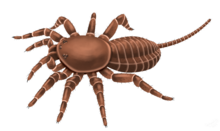尾蛛目
尾蛛目(學名:Uraraneida)是一類已滅絕的古生代蛛形綱動物,與現代蜘蛛有親緣關係。目前有兩個屬可以明確歸類為該目:發現於美國泥盆紀地層的毒首蛛屬和俄羅斯二疊紀地層的彼爾姆蛛屬。與蜘蛛一樣,它們也能產生絲,但缺乏現代蜘蛛特有的絲囊,並保留了細長的尾鞭。
| 尾蛛目 化石時期:
| |
|---|---|

| |
| 藝術家繪製的毒首蛛屬復原圖 | |
| 科學分類 | |
| 界: | 動物界 Animalia |
| 門: | 節肢動物門 Arthropoda |
| 綱: | 蛛形綱 Arachnida |
| 演化支: | 泛四肺類 Pantetrapulmonata |
| 演化支: | 四肺類 Tetrapulmonata |
| 目: | †尾蛛目 Uraraneida Selden & Shear, 2008 |
| 屬 | |
特徵
編輯第一塊被歸為該目的化石是在紐約的吉爾博亞發現的。1987年,這塊化石最初被暫時歸入已滅絕的角怖目,並被命名為Gelasinotarbus? fimbriunguis。[2]後來,這塊化石一度被認為擁有絲囊,因此被鑑定為蜘蛛,並被命名為須爪毒首蛛(Attercopus fimbriunguis)。[3]後來發現了該物種的更多標本,在與屬於彼爾姆蛛屬的標本一同研究時發現了它們與蜘蛛不一致的特徵。雖然有產絲的龍頭,但它們是沿着腹板的後緣生長的,而不是像蜘蛛那樣有一個附肢狀的絲囊。這些標本的腹部末端有一根長而有節的尾鞭,這是蜘蛛所沒有的特徵,但存在於其他蛛形綱動物中,如鞭蠍目。[4]
系統發生學與分類
編輯2014年的一項研究將尾蛛目歸入四肺類,這是一個由兩對書肺的變形(共有衍征)定義的蛛形綱動物分支。四肺類動物分為兩個主要分支,其中一個是紡織類(Serikodiastida,希臘語意為「絲綢工人」),該分支包含尾蛛目和蜘蛛目,這兩個目都能夠產生、使用蛛絲。[5]
文德利希(Wunderlich)在2015年基於同一系統發育學分析提出的另一種分類法將尾蛛目列為蜘蛛目的一個亞目,將「真正的蜘蛛」歸為蜘蛛亞目。[6]
| 塞爾登(Selden)等人 | 文德利希 |
|---|---|
紡織類 Serikodiastida
|
蜘蛛目 Araneae
|
2016年,一塊發現於賓夕法尼亞世(晚石炭世)地層的蛛形綱化石被描述為布氏父蛛(Idmonarachne brasieri)。它類似於沒有產絲器官的尾蛛目,但與尾蛛目不同的是,它的外表類似於真正的蜘蛛。晚石炭紀似乎是四肺類物種更豐富的時期,尾蛛目只是其中的一個類群。[7]2018年,兩個研究小組同時描述了一個新的分類群——來自緬甸中白堊世地層的奇美拉蛛屬,它被認為是尾蛛目的成員。[7][8] 後來的研究認為,它比尾蛛目更接近真正的蜘蛛,因為它具有尾蛛目沒有的絲囊。[9]
屬與種
編輯敦洛普(Dunlop)等人於2015年介紹了兩個物種:[10]
參考資料
編輯- ^ Huang, Diying; Hormiga, Gustavo; Cai, Chenyang; Su, Yitong; Yin, Zongjun; Xia, Fangyuan; Giribet, Gonzalo. Origin of spiders and their spinning organs illuminated by mid-Cretaceous amber fossils. Nature Ecology & Evolution. 2018-02-05, 2 (4): 623–627. ISSN 2397-334X. doi:10.1038/s41559-018-0475-9 (英語).
- ^ Shear, William A.; Selden, Paul A.; Rolfe, W.D.I.; Bonamo, Patricia M. & Grierson, James D., New terrestrial arachnids from the Devonian of Gilboa, New York, American Museum Novitates, 1987, (2901): 1–74, hdl:2246/5166
- ^ Selden, Paul A.; Shear, William A. & Bonamo, Patricia M., A spider and other arachnids from the Devonian of New York, and reinterpretations of Devonian Araneae, Palaeontology, 1991, 34: 241–281 [2024-07-29], (原始內容存檔於2018-06-28)
- ^ Selden, P.A.; Shear, W.A. & Sutton, M.D., Fossil evidence for the origin of spider spinnerets, and a proposed arachnid order, Proceedings of the National Academy of Sciences, 2008, 105 (52): 20781–20785, PMC 2634869 , PMID 19104044, doi:10.1073/pnas.0809174106
- ^ Garwood, Russell J. & Dunlop, Jason, Three-dimensional reconstruction and the phylogeny of extinct chelicerate orders, PeerJ, 2014, 2: e641, PMC 4232842 , PMID 25405073, doi:10.7717/peerj.641
- ^ Wunderlich, J., On the evolution and the classification of spiders, the Mesozoic spider faunas, and descriptions of new Cretaceous taxa mainly in amber from Burmese (Burma) (Arachnida: Araneae), Wunderlich, J. (編), Beiträge zur Araneologie 9: 21, 2015, cited in Dunlop, Penney & Jekel (2015,第127頁)
- ^ 7.0 7.1 Huang, Diying; Hormiga, Gustavo; Cai, Chenyang; Su, Yitong; Yin, Zongjun; Xia, Fangyuan; Giribet, Gonzalo, Origin of spiders and their spinning organs illuminated by mid-Cretaceous amber fossils, Nature Ecology & Evolution, 2018, 2 (4): 623–627, Bibcode:2018NatEE...2..623H, ISSN 2397-334X, PMID 29403076, S2CID 3268135, doi:10.1038/s41559-018-0475-9
- ^ Wang, Bo; Dunlop, Jason A.; Selden, Paul A.; Garwood, Russell J.; Shear, William A.; Müller, Patrick; Lei, Xiaojie, Cretaceous arachnid Chimerarachne yingi gen. et sp. nov. illuminates spider origins, Nature Ecology & Evolution, 2018, 2 (4): 614–622 [2024-07-29], Bibcode:2018NatEE...2..614W, ISSN 2397-334X, PMID 29403075, S2CID 4239867, doi:10.1038/s41559-017-0449-3, (原始內容存檔於2019-07-31)
- ^ Dunlop, Jason A. Spider Origins: a Palaeontological Perspective. Arachnology. 2022-06-27, 19 (sp1). ISSN 2050-9928. S2CID 250148030. doi:10.13156/arac.2022.19.sp1.182.
- ^ Dunlop, J.A.; Penney, D.; Jekel, D., A summary list of fossil spiders and their relatives (PDF), World Spider Catalog (Natural History Museum Bern), 2015 [2016-03-20], (原始內容存檔 (PDF)於2015-11-29)